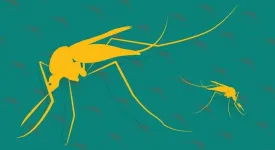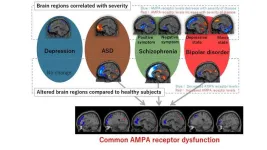Now a study out of UC Santa Barbara reveals that this is really all there is to it. Researchers in Professor Craig Montell’s lab created deaf mosquitoes and found that the males had absolutely no interest in mating. “You could leave them together with the females for days, and they will not mate,” Montell said.
The dramatic change was simple to produce. “The absence of a single gene, trpVa, produced this profound effect on mosquito mating behavior,” explained co-lead author Dhananjay Thakur, a postdoctoral scholar in the Department of Molecular, Cellular, and Developmental Biology.
The results, published in the Proceedings of the National Academy of Sciences could have major implications for how we manage disease transmission by better controlling the populations of mosquito vectors, such as Aedes aegypti, that infect hundreds of millions of people every year with viruses that cause diseases.
Frisky skeeters
“On summer evenings, we often see swarms of mosquitoes gathered by the water or under streetlights. These gatherings are essentially mass mating events,” said co-lead author Yijin Wang, a former postdoc at UCSB. Although mosquitoes possess an extraordinary ability to reproduce, scientists still have a limited understanding of the molecular and neurological mechanisms at work.
Courtship for Aedes aegypti usually progresses like this: Females flap their wings at around 500 Hz. When males hear this, they take off, buzzing at about 800 Hz. The males also rapidly modulate this frequency when the ladies are around. Then there’s a quick midair rendezvous, and the paramours go their separate ways. Males are always scouting out new potential partners, but a female that’s successfully mated generally won’t do so again.
Montell and co-lead authors Yijin Wang, Thakur and Emma Duge suspected that hearing played a role in this behavior, so they investigated the insect’s auditory neurons. These lie at the base of the antennae in a structure called the Johnston’s organ. The antennae are magnificent multi-sensory apparatuses, chock-full of olfactory, mechanosensory and even thermal infrared sensilla, as Montell’s lab recently discovered. In the current study, the team focused on a particular sensory channel called TRPVa — and the corresponding gene, trpVa — which is the mosquito analogue of a channel required for hearing in fruit flies.
The team used CRISPR-Cas9 to knock out the gene that codes for TRPVa in Aedes aegypti mosquitoes. The resulting animals showed no reaction to sound. In fact, they found that sound elicited no electrical activity from neurons in the Johnston’s organ. The insects were truly deaf.
And when the authors placed deaf males in chambers with females … nothing happened. “If they can’t hear the female wingbeat, they’re not interested,” Montell said. Their hearing counterparts, on the other hand, wasted no time in getting busy: mating many times in the course of a few minutes.
A romantic soundtrack
Hearing is not only necessary for males to mate, it seems to be sufficient to rouse their desires. When the authors played the sound of female wingbeats to normal males, the males typically responded with abdominal thrusts. They were primed and ready for action. Deaf males barely twitched.
Females, however, were a different story. Deaf females still had some lust left in them. “The impact on the female is minimal, but the impact on the male is absolute,” Montell said. The team plans to study these differences in future work.
“I think the reason why our major finding is so shocking is because, in most organisms, mating behavior is dependent on a combination of several sensory cues,” said Duge, one of Montell’s doctoral students. “The fact that taking away a single sense can completely abolish mating is fascinating.”
And the authors believe that their results — the role of sound in mating and the function TRPVa plays in hearing — generalize to other species of mosquito.
Looking inside
A mosquito’s physiology reveals just how important hearing is to these insects. Male mosquitoes have the most auditory neurons of any known insect, Montell explained. Females have half as many. That’s still a lot, but hearing is much more crucial for males.
To identify which neurons express the trpVa gene, the authors added a gene coding for green fluorescent protein into the mosquito genome. They did this in a way such that the fluorescent protein was expressed indirectly under the control of the trpVa promoter. A promoter is a DNA sequence usually located at the start of a gene where enzymes bind to initiate transcription, in this case triggering the production of those green fluorescent proteins. Now the mutant mosquitoes would produce green fluorescent protein in all the places that normally would produce TRPVa. So the same mosquitoes provided test subjects for the experiment and a bright green map of TRPVa expression for the analysis.
Unsurprisingly, the team found that trpVa is expressed in the Johnston’s organ. And they could clearly follow the paths of auditory neurons from there into the brain, as well as see differences in these paths between male and female mosquitoes.
Hijacking mosquito courtship
Pathogens spread by the mosquito Aedes aegypti infect some 400 million people a year, of which about 100 million develop diseases like dengue, zika and yellow fever. This means that understanding its behavior and lifecycle can provide us tools and insights in disease prevention.
One potential method to control insect vectors is the sterile insect technique (SIT), which works by releasing a large number of sterile males to mate with females. In certain insects, like mosquitoes, successful mating prevents females from seeking other partners. And, if the female mates with a sterile male, she doesn’t actually produce offspring. In theory, this can suppress the population.
The technique works marvelously for certain agricultural pests like the California medfly. “The fact that you haven’t heard of this pest is a testament to how successful SIT is, because 30 years ago it was all over the news,” Montell said.
But the success of SIT in Aedes aegypti is limited by the competitiveness of the sterile males; they have to get to the females first for the ploy to work. Currently, the technique doesn’t cause enough suppression in mosquito populations for them to drop below the critical threshold and send the population plummeting. Given the central role of hearing in mosquito courtship, trpVa might provide a target for increasing the effectiveness of SIT. Montell’s lab is working on several ways to make sterile males that can outcompete their natural counterparts. Hopefully, the trick will be as straightforward as these unfussy lovers.
###
Note to editors: Craig Montell is available at cmontell@ucsb.edu. Dhananjay Thakur is available at dhananjay.p.thakur@gmail.com. Emma Duge is available at emmaduge@ucsb.edu. Downloadable images can be found at https://news.ucsb.edu/2024/021664/deaf-male-mosquitoes-dont-mate.
(3426)
END









